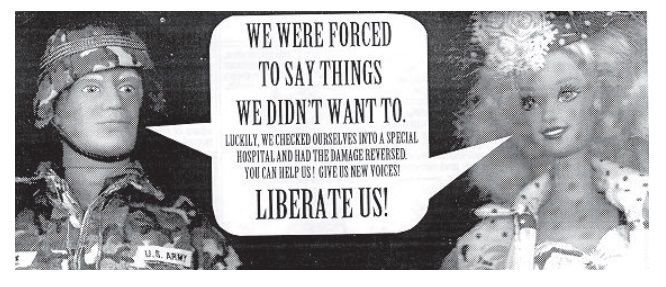Barbie is one of the most iconic dolls for girls, representing the fashion industry for toys. She defines beauty for young girls with her impossibly attainable body features. Barbie promotes primary focus on beauty standards and expensive lifestyles. Mattel, the creators of Barbie, plants the idea of consumerism in the minds of young girls without them knowing its happening. According to statistics, young girls by the age of 3 have at least 7 Barbie dolls. I probably have fifteen Barbie’s stored away myself. Also, there are at least two Barbie dolls sold every second! Although extremely popular, Barbie is also extremely controversial. Sheila Pree Bright, a photographer from Atlanta, created Plastic Bodies, which were a set of photographs that were digitally altered to show the contrast of Barbie to real women. These images focus on the problematic image of Barbie such as joining half of Barbie’s face to half of a face of another woman. Pushing more attention on the racial problems that women of color face in society, Bright expressed the fascination with an actual unrealistic, but popular, doll. Living in such a demanding society, Bright believes that Barbie is commercializing beauty and influences young girls to believe that image is everything. Magazines filled with skinny models and “perfect” celebrities surround us everywhere. Each magazine has ways for women to tone their abs followed by a celebrity who supposedly does this magical 3 minute workout. They show women they can have a perfect body like theirs in such a short time span and we believe it! Women idolize these models when in reality these models don’t even look like themselves because they are photo shopped. Drowning in celebrity image makes young girls think that what those particular celebrities have is the perfect image. But this encourages girls to get breast implants, tummy tucks, or even develop eating disorders to become more like those models and Barbie when it is physically impossible. If Barbie were to become life-sized, she would be 5’9” and only 110 lbs. She would have a BMI that is a benchmark for having anorexia and thus would not be able to menstruate. The most appalling part of her becoming life sized is that she would have to walk on all fours because of her proportions. It is so astonishing to think that women have this unhealthy model as a guide to fulfilling beauty standards. Women in the fashion industry practically replicate the beauty Barbie represents. Our society worships those with tiny waists, perfect skin and fancy clothes. These women are photo shopped down to the pores on their faces to become aesthetically perfect, or at least what society deems to be perfect. Toning the waist and fixing the nose through photo shop make these women transcend into a doll like figure. The female body becomes plastic and fake, instead of showing young girls to appreciate their own bodies without photo shop. Bright’s photos are beautiful articulated but also quite startling. When looking at these photos, the bodies of Barbie and real women are blended so well that it makes me uncomfortable to think this is what women idolize. One of her photos is of a real woman’s stomach on a Barbie’s body and it’s shocking to say the least. Imagining having a stomach that small, or wanting that small of a waist, and still having the clothes hanging off is unreal. All I can think of is how long I would have to go without eating to obtain this. I can only imagine how young girls who haven’t learned to love their bodies feel. Younger girls with body issues could try to obtain this perfect image in incredibly unhealthy and dangerous ways. Another issue is of race since most of the Barbie dolls created were white or based around a white figure. Colored Francie, an African American Barbie doll was produced with the same mold as the white Barbie. Controversy rose because this Barbie did not appreciate or accurately depict true beauty in the African American culture. She was described as a white Barbie simply dipped in chocolate. In the image with half of an African American Barbie with an African American woman, the difference is striking because of how much the faces contrast. The Barbie side has green eyes and smaller lips. Mattel did not take into consideration the difference in cultures but neither the beauty in those differences. Although seemingly ignorant to other cultures, Barbie still sells at an amazing rate.
#barbie #africanamerican #mattel


